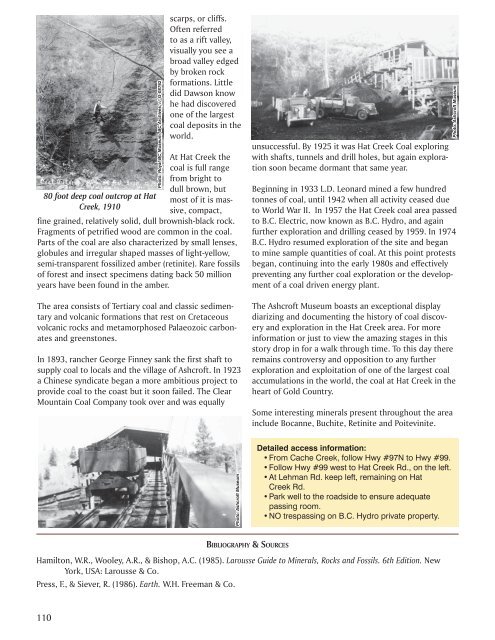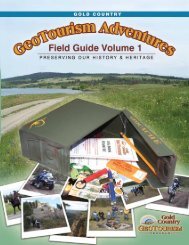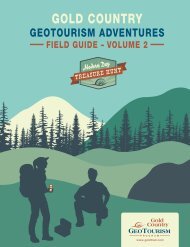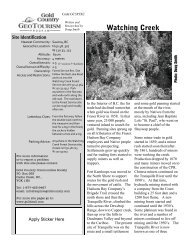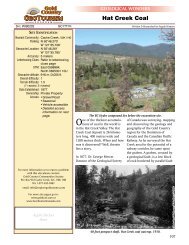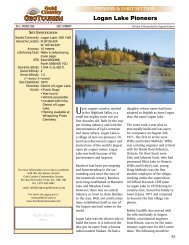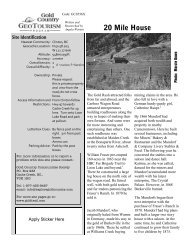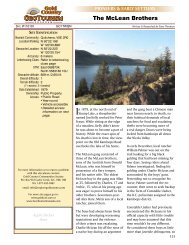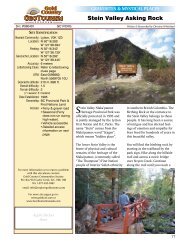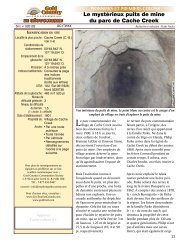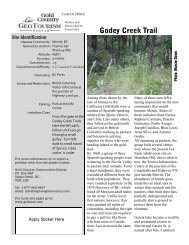E book Field Guide.indd - Gold Country
E book Field Guide.indd - Gold Country
E book Field Guide.indd - Gold Country
Create successful ePaper yourself
Turn your PDF publications into a flip-book with our unique Google optimized e-Paper software.
80 foot deep coal outcrop at Hat<br />
Creek, 1910<br />
scarps, or cliffs.<br />
Often referred<br />
to as a rift valley,<br />
visually you see a<br />
broad valley edged<br />
by broken rock<br />
formations. Little<br />
did Dawson know<br />
he had discovered<br />
one of the largest<br />
coal deposits in the<br />
world.<br />
At Hat Creek the<br />
coal is full range<br />
from bright to<br />
dull brown, but<br />
most of it is massive,<br />
compact,<br />
fine grained, relatively solid, dull brownish-black rock.<br />
Fragments of petrified wood are common in the coal.<br />
Parts of the coal are also characterized by small lenses,<br />
globules and irregular shaped masses of light-yellow,<br />
semi-transparent fossilized amber (retinite). Rare fossils<br />
of forest and insect specimens dating back 50 million<br />
years have been found in the amber.<br />
The area consists of Tertiary coal and classic sedimentary<br />
and volcanic formations that rest on Cretaceous<br />
volcanic rocks and metamorphosed Palaeozoic carbonates<br />
and greenstones.<br />
In 1893, rancher George Finney sank the first shaft to<br />
supply coal to locals and the village of Ashcroft. In 1923<br />
a Chinese syndicate began a more ambitious project to<br />
provide coal to the coast but it soon failed. The Clear<br />
Mountain Coal Company took over and was equally<br />
Photo: Royal BC Museum, BC Archives, n o G-08762<br />
unsuccessful. By 1925 it was Hat Creek Coal exploring<br />
with shafts, tunnels and drill holes, but again exploration<br />
soon became dormant that same year.<br />
Beginning in 1933 L.D. Leonard mined a few hundred<br />
tonnes of coal, until 1942 when all activity ceased due<br />
to World War II. In 1957 the Hat Creek coal area passed<br />
to B.C. Electric, now known as B.C. Hydro, and again<br />
further exploration and drilling ceased by 1959. In 1974<br />
B.C. Hydro resumed exploration of the site and began<br />
to mine sample quantities of coal. At this point protests<br />
began, continuing into the early 1980s and effectively<br />
preventing any further coal exploration or the development<br />
of a coal driven energy plant.<br />
The Ashcroft Museum boasts an exceptional display<br />
diarizing and documenting the history of coal discovery<br />
and exploration in the Hat Creek area. For more<br />
information or just to view the amazing stages in this<br />
story drop in for a walk through time. To this day there<br />
remains controversy and opposition to any further<br />
exploration and exploitation of one of the largest coal<br />
accumulations in the world, the coal at Hat Creek in the<br />
heart of <strong>Gold</strong> <strong>Country</strong>.<br />
Some interesting minerals present throughout the area<br />
include Bocanne, Buchite, Retinite and Poitevinite.<br />
Photo: Ashcroft Museum<br />
Photo: Ashcroft Museum<br />
Detailed access information:<br />
• From Cache Creek, follow Hwy #97N to Hwy #99.<br />
• Follow Hwy #99 west to Hat Creek Rd., on the left.<br />
• At Lehman Rd. keep left, remaining on Hat<br />
Creek Rd.<br />
• Park well to the roadside to ensure adequate<br />
passing room.<br />
• NO trespassing on B.C. Hydro private property.<br />
BIBLIOGRAPHY & SOURCES<br />
Hamilton, W.R., Wooley, A.R., & Bishop, A.C. (1985). Larousse <strong>Guide</strong> to Minerals, Rocks and Fossils. 6th Edition. New<br />
York, USA: Larousse & Co.<br />
Press, F., & Siever, R. (1986). Earth. W.H. Freeman & Co.<br />
110


